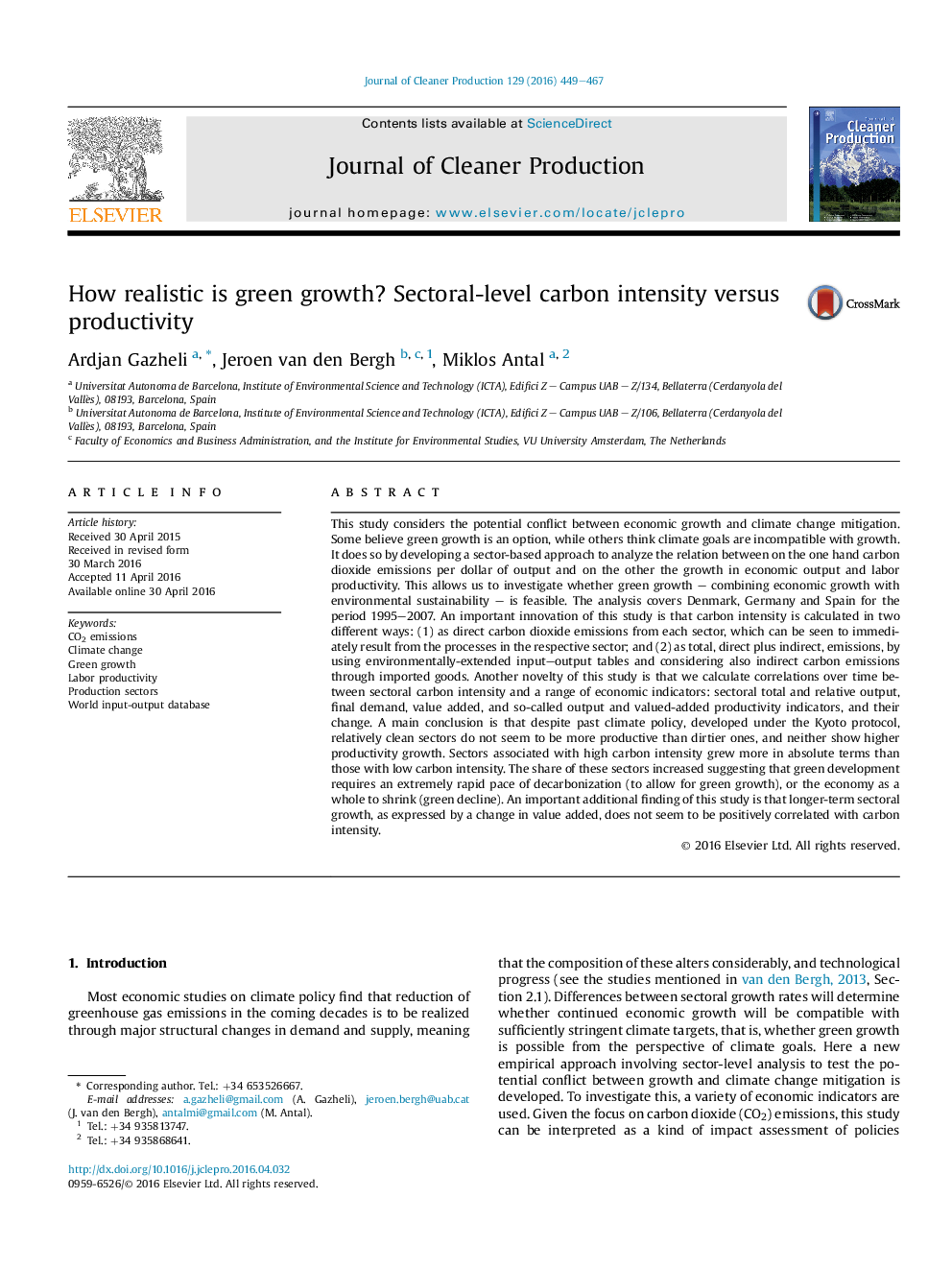| کد مقاله | کد نشریه | سال انتشار | مقاله انگلیسی | نسخه تمام متن |
|---|---|---|---|---|
| 8101934 | 1522120 | 2016 | 19 صفحه PDF | دانلود رایگان |
عنوان انگلیسی مقاله ISI
How realistic is green growth? Sectoral-level carbon intensity versus productivity
ترجمه فارسی عنوان
رشد سبز واقعی چگونه است؟ شدت کربن در مقیاس صنعت در مقایسه با بهره وری
دانلود مقاله + سفارش ترجمه
دانلود مقاله ISI انگلیسی
رایگان برای ایرانیان
کلمات کلیدی
ترجمه چکیده
این مطالعه در مورد مناقشه بالقوه بین رشد اقتصادی و کاهش تغییرات اقلیمی است. برخی معتقدند رشد سبز یک گزینه است، در حالی که برخی دیگر معتقدند که اهداف آب و هوایی با رشد اقتصادی سازگار نیستند. این کار با ایجاد یک رویکرد مبتنی بر بخش برای تجزیه و تحلیل رابطه بین انتشار دی اکسید کربن در هر دلار از تولید و از سوی دیگر رشد تولیدات اقتصادی و بهره وری نیروی کار است. این به ما اجازه می دهد تا بررسی کنیم که آیا رشد سبز - ترکیب رشد اقتصادی با پایداری محیطی - امکان پذیر است. این تجزیه و تحلیل شامل دانمارک، آلمان و اسپانیا در دوره 1995-2007 است. یک نوآوری مهم در این مطالعه این است که شدت کربن به دو روش مختلف محاسبه می شود: (1) به عنوان انتشار دی اکسید کربن مستقیم از هر بخش، که می تواند بلافاصله ناشی از روند در بخش مربوطه باشد؛ و (2) به عنوان کل، مستقیم به علاوه غیر مستقیم، انتشار، با استفاده از جداول خروجی محیط زیست گسترش یافته و با توجه به همچنین انتشار غیر کربن غیر مستقیم از طریق کالاهای وارداتی. یکی دیگر از اخبار این مطالعه این است که ما در طول زمان از همبستگی بین شدت کربن بخش بندی و طیف وسیعی از شاخص های اقتصادی محاسبه می کنیم: تولید ناخالص داخلی، تولید ناخالص داخلی، تقاضای نهایی، ارزش افزوده و به اصطلاح شاخص تولید بهره وری و ارزش افزوده و تغییر آنها . نتیجه گیری اصلی این است که علیرغم سیاست های گذشته آب و هوایی، که تحت پروتکل کیوتو توسعه داده شده، بخش های نسبتا تمیز به نظر نمی رسد که تولید کننده تر از محصولات کثیف تر باشند و رشد تولید ناخالص را نشان دهند. بخش های مرتبط با شدت کربن بالا در شرایط مطلق بیشتر از کسانی است که دارای شدت کم کربن هستند. سهم این بخش ها افزایش یافته است که نشان می دهد که توسعه سبز نیاز به سرعت بسیار سریع کربن زدایی دارد (به سبب رشد سبز) و یا اقتصاد به طور کلی کاهش می یابد (کاهش سبز). یکی دیگر از یافته های مهم این مطالعه این است که رشد بخش های بلندمدت، که بیانگر تغییر در ارزش افزوده است، به نظر نمی رسد که با شدت کربن رابطه مثبت داشته باشد.
موضوعات مرتبط
مهندسی و علوم پایه
مهندسی انرژی
انرژی های تجدید پذیر، توسعه پایدار و محیط زیست
چکیده انگلیسی
This study considers the potential conflict between economic growth and climate change mitigation. Some believe green growth is an option, while others think climate goals are incompatible with growth. It does so by developing a sector-based approach to analyze the relation between on the one hand carbon dioxide emissions per dollar of output and on the other the growth in economic output and labor productivity. This allows us to investigate whether green growth - combining economic growth with environmental sustainability - is feasible. The analysis covers Denmark, Germany and Spain for the period 1995-2007. An important innovation of this study is that carbon intensity is calculated in two different ways: (1) as direct carbon dioxide emissions from each sector, which can be seen to immediately result from the processes in the respective sector; and (2) as total, direct plus indirect, emissions, by using environmentally-extended input-output tables and considering also indirect carbon emissions through imported goods. Another novelty of this study is that we calculate correlations over time between sectoral carbon intensity and a range of economic indicators: sectoral total and relative output, final demand, value added, and so-called output and valued-added productivity indicators, and their change. A main conclusion is that despite past climate policy, developed under the Kyoto protocol, relatively clean sectors do not seem to be more productive than dirtier ones, and neither show higher productivity growth. Sectors associated with high carbon intensity grew more in absolute terms than those with low carbon intensity. The share of these sectors increased suggesting that green development requires an extremely rapid pace of decarbonization (to allow for green growth), or the economy as a whole to shrink (green decline). An important additional finding of this study is that longer-term sectoral growth, as expressed by a change in value added, does not seem to be positively correlated with carbon intensity.
ناشر
Database: Elsevier - ScienceDirect (ساینس دایرکت)
Journal: Journal of Cleaner Production - Volume 129, 15 August 2016, Pages 449-467
Journal: Journal of Cleaner Production - Volume 129, 15 August 2016, Pages 449-467
نویسندگان
Ardjan Gazheli, Jeroen van den Bergh, Miklos Antal,
